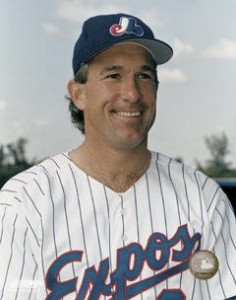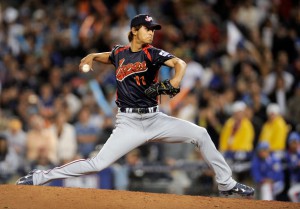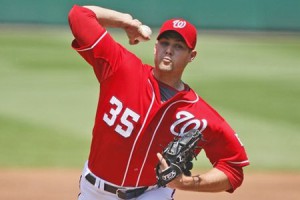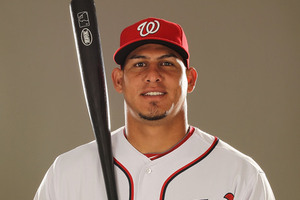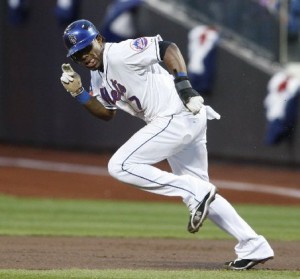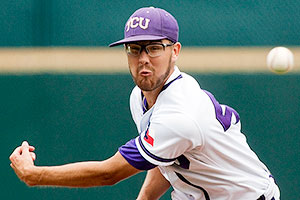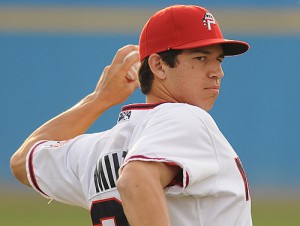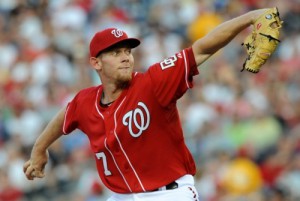This is your semi-weekly/periodic wrap-up of Nats and other baseball news that caught my eye. I try to publish this about weekly or if it gets up to about 1500 words, so that it’s not to voluminous.
Nationals In General
- Mark Zuckerman writes about a favorite topic of mine w/r/t the current Nats 40-man roster and its construction. See here for a similar discussion of the 2011 Nats (along with analysis of the 8 playoff teams) from last October. Clearly the more players you’re using as your “primary 15” that were developed in house, the better you’re doing as a player development machine. But there’s also the measure of cashing in those prospects in order to acquire resources. (Coincidentally the “primary 15” of a team means its 8 starters in the field, 5 rotation members, setup man and closer). By last year’s end, the Nats were starting 9 of these 15 as players developed in house and were down to just three acquired via FA/Waivers. That’s a massive step up from just a few years prior, when most of the team was FA/Waiver pickups. We’ll revisit this topic once the 25-man rosters for teams are finalized and play starts in April.
- The Washington Franchise leads the league in employment of Negative WAR players over the past decade. A staggering 31% of our players in this time have shown negative WARs per season. This is not surprising given what we know of the construction of the first few iterations of the Nationals; Zuckerman has done studies in the past related to the staggering number of players the Nats have played at the MLB level who, after leaving us, never appeared in a major league game again. The last time Zuckerman did this study that I could find was Nov 2010, when he identified 59 such players just since 2005. I don’t know what percentage that is of all players who appeared for us in that time-frame, but it seems high. (note: I just did some analysis and will return with a blog posting on this topic soon).
- Back to the negative war topic, here’s a list of such negative WAR seasons for the 2011 iteration of the team: Alex Cora, Jesus Flores, Chris Marrero, Steve Lombardozzi, Matt Stairs, Livan Hernandez, Doug Slaten, Brian Broderick, Yuniesky Maya, Collin Balester and Chad Gaudin. That’s 11 of the 44 players who appeared in the majors for us last year, or exactly 25%. So we’re not exactly out of the woods yes; clearly we continue to employ a ton of players who end up hurting the team. (For the record I used bWAR instead of fWAR for this, since its a bit easier to see that data. But i’d guess the analysis would come out the same for either measurement method).
- Another article on Edwin Jackson and pitch-tipping. Is it possible that a player could play for years and never have a hitter teammate tell him he’s tipping his pitches? I think it depends on what team the pitcher plays for. Mike Mussina infamously was told he tipped his change up once he moved to the Yankees, and he made the adjustment that enabled his stellar 2006 season. Maybe the team should have just kept its mouth shut about their thoughts and not told every reporter in every press conference that they think their new $11M pitcher is flawed.
Free Agents/Player Transaction News
- Interesting thoughts on whether “4-A” players really do exist and how to quantify them from Fangraphs.com. Read through the comments for some better thoughts. For me, this issue touches on two opinions I’ve been growing. 1st; yes there does exist 4-A players; the Nats have shown to have a slew of them recently. Guys whose minor league performance literally disappears upon reaching the majors. I don’t know how to quantify it but there’s clearly guys who bounce freely between the two levels and seem destined to max out as such a 4-A player. 2ndly: Is AAA now a “lesser” league than AA? Perhaps not with all systems (for example, Tampa Bay insists all their prospects play full seasons at each level, as does Atlanta), but for the Nats we’ve seen some interesting promotion behavior lately. Stephen Strasburg got hit harder in AA than in AAA during his brief minor league apprenticeship, but the difference is rather slight. But watching the games you got the distinct feeling that his AA competition was getting decent wood on the bat, while in AAA it was like he was pitching to little leaguers. This goes to my theory that AAA is morphing into a “spare parts” league, where teams stash backup utility players (mostly catchers, middle infielders, relief pitchers) who are on the 40-man and can quickly be recalled to fill a spot, while AA is the place where your rising prospects play full seasons in preparation for promotion to the majors. Jordan Zimmermann never pitched a AAA inning, rising from a full season in Harrisburg straight to our rotaton. Strasburg probably could have done the same. Will we see Bryce Harper jump straight from AA to the Majors or will the strategy of Mike Rizzo going forward be more Tampa-esque, requiring each prospect to “master” each level rising upwards?
- A surprise team lands Yoenis Cespedes, namely the penny-pinching Oakland A’s in a 4yr/$36M deal. 4 years and $36M!? That’s more than they will spend in payroll on their entire TEAM in 2012. Maybe. That’s a lot of cash for a completely unproven, if talented player who I’d say is not entirely MLB ready.
General Baseball News
- Excellent article on the Demise of the Spitball and other Doctoring techniques from Grantland’s Jonah Keri, whose writing I’ve always liked and who is working on a historical retrospective on the Montreal Expos franchise. Keri’s article talks about the Kenny Rogers pine-tar incident in the 2006 World series, but I don’t consider that “doctoring” the baseball. That was simply using pine-tar to get a better grip on a cold, wet night. Not that its legal; just different from the more conventional definition of a “spitball.” Keri’s conclusion as to why the spitball has disappeared is attributed to the invention of the modern split-fingered fastball (attributed to Bruce Sutter) and to the lack of proper teachers (the craft of doctoring the ball has been handed down generation to generation by pitching coaches). But honestly I believe the decline is more attributable to two other factors; the lingering stigma of getting caught being higher now post-PED era than every before, and the fact that the true “spitball” is damn difficult to throw (imagine trying to “throw” a baseball with the same motion you might use to squirt a pumpkin seed from your fingers? That’s what throwing a spitball is like to a certain extent).
- In typical modern day sabrematrician blogger nerd fashion, someone at a stats-oriented site goes about attacking another writer’s observation column. In this case, it is someone at Baseball Prospectus attacking the Verducci Effect. I can’t argue with his stats (other than to quibble with the lack of publication of his control group for comparison), but I suspect he misses the point. I don’t think Verducci passes this list off as a statistical study; i think its passed off as a subjective list of candidate pitchers who HE THINKS may regress. See, there’s the rub. He’s already done the breakdown from the “control” group of pitchers who may be candidates for his study but whom he thinks may not be in jeopardy. So I’m presuming that, because of this pre-selection and expression of opinion this is no longer a statistical study but an opinion piece. I’d liken it to analyzing statistically the results of an amateur scout’s player recommendations; sure you could run one in order to judge a scout’s prognostication ability, but there’s so much variation in what happens to players once they sign that it wouldn’t be meaning ful. I guess my take away is this: Verducci does a pretty durn good job of predicting red-flags for these pitchers (84% over the past 5 years), that maybe we should just recognize his study for what it is, and not overanalyze it to try to discredit it.
- A nice article about another favorite topic of mine: the relationship between Wins and salary. The familiar narrative is that payroll discrepancies are killing modern baseball, and to a certain extent I do agree; its no coincidence that the high payroll Yankees have only missed one playoff appearance in the nearly-20 years since the wild card era began. But the ratio of wins to salary is dropping. Why? Because several teams have sacrificed several seasons to basically reset and start over. Tampa Bay and Texas are the best recent examples, but we’re also seeing remnants of this theory here in Washington and starting anew in Houston and Chicago.
- Nice little Intro to Sabremetrics from Espn-W. The author doesn’t go into the real in-depth stats that a lot of people are gravitating to but does cover the basics. OPS, Fip, UZr, wOBA, Vorp and WAR. Now if we could only decide on a standard WAR.
- Another classy move from baseball’s classiest organization; the Miami Marlins. Yeah, lets un-retire the number of a former employee who died tragically since, well, he didn’t work for the current ownership group.
General News; other
- Excellent article at Grantland.com on the Effects of CTE and the possible future (end?) of Football as we know it. This is something I have been saying for a while and agree with; the increased awareness of concussions and their relationship to the longer term effects (the affliction known as Chronic Traumatic Encephalopathy or CTE) may soon start to really change the way that people think about the sport. More to the point, as a parent does the thought of repeated concussions inflicted on your young football-playing son give you pause? It would for me. Read this article and it makes some very good points. 90,000 recorded pre-collegiate concussions per year?!
